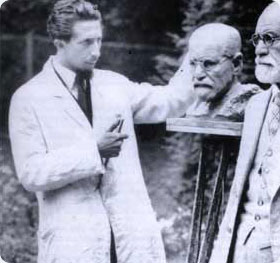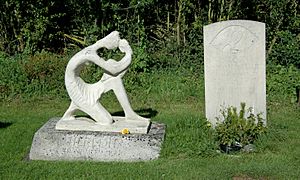Oscar Nemon facts for kids
Quick facts for kids
Oscar Nemon
|
|
|---|---|
 |
|
| Born |
Oscar Neumann
13 March 1906 Osijek, Kingdom of Croatia-Slavonia, Austria-Hungary
|
| Died | 13 April 1985 (aged 79) |
| Known for | Sculpture |
Oscar Nemon (born Oscar Neumann; 13 March 1906 – 13 April 1985) was a famous sculptor. He was born in Osijek, Croatia. Later, he moved to England and made it his home. He is especially known for creating many public statues of Sir Winston Churchill. There are more than a dozen of these statues.
Contents
A Young Artist's Journey
Oscar Nemon grew up in a Jewish family in Osijek. He was the second child and the older son of Mavro and Eugenia Neumann. Mavro made medicines. Oscar showed artistic talent from a young age. He started shaping clay at a local brickworks.
Even while still in school, he showed his early artworks. This happened in Osijek in 1923 and 1924. After finishing school, he was encouraged to study art in Paris. However, he chose to go to Vienna instead.
In Vienna, he tried to get into the Academy of Fine Arts. He didn't get a spot there. So, he worked for a while at his uncle's bronze foundry. There, he met Sigmund Freud, a famous thinker. Nemon even sculpted Freud's dog, Topsy. He also made a sculpture of Princess Marie Bonaparte. Later in his life, Oscar changed his last name from Neumann to Nemon.
Moving to Brussels and Important Works
After a short time studying in Paris, Nemon moved to Brussels in 1925. He studied at the Académie Royale des Beaux-Arts. He even won a gold medal for his sculptures there. Brussels became his home until 1939. For much of the 1930s, he shared a house with the painter René Magritte.
In 1928, he created a monument called "June Victims" for his hometown of Osijek. This monument remembered Croatian politicians who were shot in 1928. In 1931, Nemon went back to Vienna. He created a large sculpture of Sigmund Freud sitting down. This sculpture is now in Hampstead, England.
Nemon also held an exhibition of his portrait sculptures. These included his Freud sculpture and a bust of Paul-Henri Spaak. He made portraits of King Albert I and Queen Astrid of the Belgians. He also showed his work in galleries in Brussels.
Escaping Danger and Starting a Family
As Nazi Germany became a threat, Nemon left for England in 1938. This was a year before World War II began. He had to leave behind many years of his work in his studio. Most of his family stayed in Europe and were lost during the the Holocaust.
In 1939, Nemon married Patricia Villiers-Stuart. They first lived in Oxford, then in Headington. Finally, they settled in Boars Hill. They had three children: a son named Falcon and two daughters, Aurelia and Electra. Falcon became a photographer and filmmaker. Aurelia married a politician, and Electra married a musician.
Life and Work in England
In 1941, Nemon made a bust of Max Beerbohm, who helped him learn English. The family moved to Boars Hill permanently in 1941. They lived in rented rooms and then in special huts. Nemon bought land there and named it "Pleasant Land." In the 1960s, he designed and built his own house and studio on this land.
In 1942, he showed some of his portraits in Oxford. He also sculpted the director of the Tate Gallery and Sir Karl Parker of the Ashmolean Museum. In 1948, he officially became a British citizen.
After the war, Nemon sculpted many important people. He made portraits of members of the British Royal Family. These included Queen Elizabeth II, the Duke of Edinburgh, and the Queen Mother. He also sculpted war leaders like Dwight D. Eisenhower and Viscount Montgomery. Other political figures he sculpted were Harold Macmillan and Margaret Thatcher.
Nemon is most famous for his many public statues of Winston Churchill. You can find these statues in places like the House of Commons and Westerham. His last big artwork was a memorial for the Royal Canadian Air Force in Toronto. Queen Elizabeth II unveiled it in 1984. During the 1940s and 1950s, he also created smaller artworks called "Les Fleurs de mon Coeur."
In 1977, the University of St. Andrews gave him an honorary degree. The Ashmolean Museum held a special show of his art in 1982. Oscar Nemon passed away on 13 April 1985 in Oxford. A memorial exhibition of his work was held in Osijek that same year.
Sculpture Techniques and Legacy
Nemon's way of sculpting involved working directly with clay. He would quickly make many small studies without drawing first. He created art using clay, plaster, and stone. However, most of his finished works were made from bronze. These were often cast at special art foundries.
His house and studio, Pleasant Land, were closed for 17 years after he died. It reopened in 2003 as a museum. The museum shows many of his studies and models. It also keeps his important papers. Other papers about his sculptures of Winston Churchill and Margaret Thatcher are kept in Cambridge.
Gallery
-
Oscar Nemon's Montgomery in Whitehall, London
-
Oscar Nemon's Statue of Sir Winston Churchill at Westerham, erected in 1969 on a stone plinth donated by Marshal Tito of Yugoslavia








